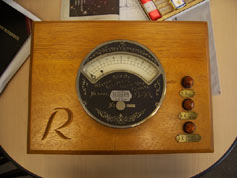
Handy Links
SLAC News Center
SLAC Today
- Subscribe
- Archives: Feb 2006-May 20, 2011
- Archives: May 23, 2011 and later
- Submit Feedback or Story Ideas
- About SLAC Today
SLAC News
Lab News
- Interactions
- Lightsources.org
- ILC NewsLine
- Int'l Science Grid This Week
- Fermilab Today
- Berkeley Lab News
- @brookhaven TODAY
- DOE Pulse
- CERN Courier
- DESY inForm
- US / LHC
SLAC Links
- Emergency
- Safety
- Policy Repository
- Site Entry Form

- Site Maps
- M & O Review
- Computing Status & Calendar
- SLAC Colloquium
- SLACspeak
- SLACspace
- SLAC Logo
- Café Menu
- Flea Market
- Web E-mail
- Marguerite Shuttle
- Discount Commuter Passes
-
Award Reporting Form
- SPIRES
- SciDoc
- Activity Groups
- Library
Stanford
Around the Bay
Measuring Particle Creation in Style
 When you're waiting around for rare particles to present themselves, sometimes it helps to have something nice to look at. That was the rationale behind the ornate and anachronistic rate-meter (or R-meter), which was installed in the SPEAR control room in 1974.
When you're waiting around for rare particles to present themselves, sometimes it helps to have something nice to look at. That was the rationale behind the ornate and anachronistic rate-meter (or R-meter), which was installed in the SPEAR control room in 1974.
The stylish gauge was recently donated to SLAC by former director Burton Richter, who kept the meter for safekeeping. Richter shares the 1976 Nobel Prize in Physics for the discovery of the J/psi particle, which helped confirm the existence of the charm quark.
The R-meter consists of an old Weston voltmeter that dates from the early 1900s and a digital-to-analog converter. Connected to a fast computer that did the real-time data analysis, it served as an informative faceplate that reflected the rate at which new quarks were created in SPEAR's Mark II detector. The R stands for the "R Ratio," the ratio of the number of hadron events to muon pair events that occur when e+ and e- beams annihilate.
"We liked it because it was pretty," said Richter. "The old fashioned powerhouse meter was much better than the dullness of a computer display."
The R-meter was installed after the J/psi particle was discovered at SPEAR, when the R value shot up to more than 100 times the baseline. The meter followed Mark II to the PEP storage ring and later to the Stanford Linear Collider (SLC).
"It was kind of a joke at the time, this huge analog voltmeter hooked up to the modern computer," says Rafe Schindler, who helped put the meter together as a graduate student. "It ended up having a very distinguished career."
In 1974, the voltmeter was salvaged from a basement storeroom in the Stanford Physics Department. Group C technician Clarence Noyer, a boating enthusiast, constructed a mahogany wood housing carved with the letter "R." Marty Breidenbach and David Nelson made a CAMAC module to interface the meter with the computer.
Three old-style panel lights on the side of the R-meter indicate whether the reading of the voltmeter should be multiplied by one, 10, or 100.
Exactly who borrowed the voltmeter from the Stanford storeroom is being kept under wraps. "I don't know what the statute of limitations is on meter theft," said Richter.
—Rachel Courtland
SLAC Today, November 10, 2006
Above image: The R-Meter will be on display in the office of Communications Director Neil Calder (Building 40, Room G106) for the next three weeks. (Click on image for larger version, or stop by Neil's office to see it firsthand.)